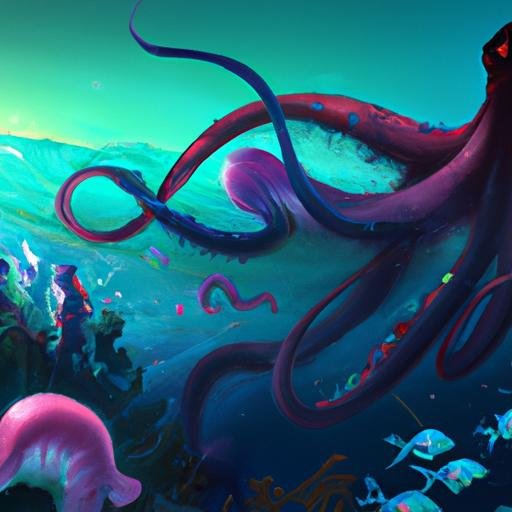Now Reading: 2. “Exploring the Wonders of Deep Sea Creatures”
- 01
2. “Exploring the Wonders of Deep Sea Creatures”

2. “Exploring the Wonders of Deep Sea Creatures”
Dive into the mysterious depths of the ocean and discover the captivating world of deep sea creatures. From bizarre bioluminescent organisms to elusive giant squids, these fascinating creatures are bound to leave you in awe. Join us as we embark on an exploration of the wonders that lie beneath the surface of the sea.
Exploring the Intriguing Biodiversity of Deep Sea Creatures
Deep sea creatures are some of the most mysterious and fascinating organisms on our planet. These unique animals have evolved to thrive in the extreme conditions of the deep ocean, where sunlight barely reaches and the pressure is immense. From deep-sea anglerfish with their bioluminescent lures to giant squids with eyes the size of basketballs, the biodiversity of deep-sea creatures never ceases to amaze.
One of the most intriguing aspects of deep-sea creatures is their ability to adapt to such harsh environments. Many of these animals have developed specialized adaptations to survive in the dark, cold depths of the ocean. Some deep-sea creatures have evolved to produce their own light through bioluminescence, while others have unique sensor organs to detect movement in the pitch-black waters. The sheer diversity of deep-sea creatures and their adaptations is a testament to the incredible adaptability of life on Earth.
Majestic Creatures That Thrive in Extreme Conditions
Deep below the ocean’s surface, there exists a mysterious world filled with creatures that have adapted to survive in the extreme conditions of the deep sea. These majestic beings thrive in the darkness and cold pressures of the ocean depths, showcasing incredible feats of evolution and resilience.
- Glowing Lanternfish: These small fish possess bioluminescent organs that emit light, helping them camouflage in the dark depths of the ocean while also attracting prey.
- Giant Tube Worms: These bizarre creatures can reach lengths of up to 8 feet and live near hydrothermal vents, where they rely on symbiotic bacteria to survive in the extreme heat and chemicals of the vent environment.
Unique Adaptations of Deep Sea Creatures
From glowing lights to bizarre body shapes, deep sea creatures possess some of the most unique adaptations in the animal kingdom. One fascinating example is the anglerfish, which features a bioluminescent lure on its forehead to attract prey in the dark depths of the ocean. This clever adaptation allows the anglerfish to easily catch its next meal without expending too much energy.
Another extraordinary deep sea creature is the vampire squid, which has the ability to turn itself inside out as a defense mechanism. When threatened, the vampire squid wraps its webbed arms around its body, creating a spiky ball that confuses predators. This unusual adaptation helps the vampire squid evade danger and survive in the harsh environment of the deep sea.
Incredible Bioluminescence in the Depths of the Ocean
The depths of the ocean hold an array of mesmerizing bioluminescent creatures that light up the dark waters with their enchanting glow. These deep-sea organisms have evolved to produce their own light through a chemical reaction, attracting both prey and mates in the pitch-black environment. From tiny plankton to large predators, the ocean is alive with bioluminescence that creates a stunning spectacle unlike anything on land.
One of the most incredible deep-sea creatures that showcases bioluminescence is the anglerfish. With a bioluminescent lure dangling in front of its enormous mouth, this predatory fish attracts unsuspecting prey in the darkness of the deep ocean. Additionally, deep-sea jellyfish, squid, and shrimp all possess bioluminescent capabilities, adding to the mystical beauty of the ocean depths. Exploring these wonders of nature reveals the fascinating adaptations and survival strategies of creatures that dwell in the mysterious world beneath the waves.
The Mysterious World of Deep Sea Jellyfish
Deep sea jellyfish are some of the most mesmerizing and enigmatic creatures on our planet. These gelatinous beings drift effortlessly through the dark depths of the ocean, their translucent bodies glowing with bioluminescent colors. As they move gracefully through the water, their tentacles trailing behind them like ethereal ribbons, they create an otherworldly spectacle that captivates all who behold them.
One of the most fascinating aspects of deep sea jellyfish is their ability to adapt to extreme environments. These creatures have evolved unique anatomical features that allow them to thrive in the cold, dark, high-pressure conditions of the deep sea. From their delicate, umbrella-shaped bells to their intricate, stinging tentacles, deep sea jellyfish are a testament to the incredible diversity of life that exists in the uncharted depths of the ocean.
If you ever have the opportunity to witness these mysterious creatures in their natural habitat, take a moment to marvel at the wonders of the deep sea and the incredible adaptations that allow jellyfish to survive and thrive in such a harsh environment.
Discovering the Enigmatic Giant Squid
The depths of the ocean hold many mysteries, and one of the most enigmatic creatures to inhabit these dark waters is the giant squid. Measuring up to 43 feet in length, this elusive cephalopod has captured the imagination of scientists and researchers for centuries.
Despite its massive size, the giant squid is rarely seen alive in its natural habitat, making it one of the most elusive creatures in the ocean. Known for its long tentacles and large, intelligent eyes, this deep-sea dweller has been the subject of many myths and legends throughout history.
The Diverse Diet of Deep Sea Creatures
When it comes to deep sea creatures, their diet is as diverse as the ocean depths they inhabit. These fascinating creatures have adapted to survive in some of the most extreme conditions on Earth, leading to a wide range of feeding habits and preferences.
From scavenging on decaying organic matter to hunting prey with specialized adaptations, deep sea creatures have evolved to take advantage of whatever food sources are available in their dark and often barren environment. Some species have developed bioluminescent lures to attract unsuspecting prey, while others rely on filter feeding to capture tiny particles from the water. With such a variety of feeding strategies at play, the deep sea is truly a treasure trove of biological diversity.
The Importance of Deep Sea Conservation Efforts
The deep sea is home to an incredible array of unique and fascinating creatures that have adapted to survive in some of the harshest environments on Earth. From bioluminescent fish that light up the dark depths to giant squid that lurk in the shadows, the deep sea is truly a world of wonders waiting to be explored. By protecting and conserving these fragile ecosystems, we can ensure that these amazing creatures continue to thrive for generations to come.
Through research and conservation efforts, scientists are uncovering new species and gaining a better understanding of the deep sea environment. These efforts are essential for preserving biodiversity and maintaining the delicate balance of marine ecosystems. By raising awareness about the importance of deep sea conservation, we can inspire others to join in the effort to protect these incredible creatures and their habitats.
Unveiling the Secrets of Deep Sea Octopuses
Deep sea octopuses are fascinating creatures that inhabit some of the most remote and unexplored parts of our oceans. These mysterious cephalopods have evolved unique adaptations to survive in the extreme conditions of the deep sea, making them a subject of great interest for scientists and researchers.
One of the most intriguing secrets of deep sea octopuses is their remarkable intelligence. These creatures have complex nervous systems and are capable of problem-solving and learning through observation. They have also been observed using tools, such as rocks and shells, to defend themselves or manipulate their environment. Their ability to adapt and thrive in such harsh environments is a testament to the incredible diversity and resilience of life on our planet.
The Fascinating Reproduction Strategies of Deep Sea Creatures
Deep sea creatures have evolved some of the most fascinating reproduction strategies in the animal kingdom. One such example is the anglerfish, where the male is much smaller than the female and fuses to her body, essentially becoming a parasite. This unique mating method allows the male to receive nutrients from the female while providing sperm for fertilization.
Another interesting deep sea creature with a unique reproduction strategy is the vampire squid. This mysterious creature can produce bioluminescent fluid that it releases during mating rituals, attracting potential mates. Once fertilized, the female vampire squid can lay hundreds of gelatinous eggs that float in the water column, ensuring their survival in the dark depths of the ocean.
Tips for Responsible Deep Sea Creature Watching
When embarking on a deep sea creature watching adventure, it’s important to remember that responsible behavior is key to preserving these magnificent marine beings and their habitats. Here are some tips to ensure that your experience is not only enjoyable but also respectful towards the creatures you encounter:
- Minimize Disturbance: Keep a safe distance from the creatures to avoid stressing them out or disrupting their natural behaviors.
- Respect Their Space: Do not touch or feed the creatures, as this can interfere with their ecosystem and potentially harm them.
- Stay Informed: Educate yourself on the local regulations and guidelines for deep sea creature watching to ensure you are following best practices.
To Conclude
As we dive back up to the surface, we leave behind the mysterious world of deep sea creatures, a realm filled with unimaginable wonders and creatures that continue to astound scientists and explorers alike. From glowing anglerfish to colossal squids, the deep sea holds a wealth of secrets waiting to be unraveled. So next time you find yourself gazing out at the ocean, remember that beneath the waves lies a world just waiting to be explored. Who knows what other incredible creatures lie waiting in the depths below? The possibilities are as endless as the deep blue sea.











